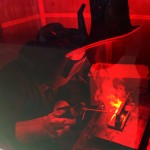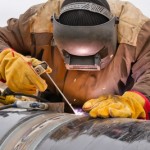Welding in vehicle body construction: The most important facts and protective measures
Identifying potential hazards and eliminating them professionally: one of the many challenges in vehicle body construction. Hazardous substances such as oxides and ozone among others are produced during welding work with composite materials such as aluminium and steel. If these substances are not properly extracted, they can lead to serious respiratory diseases. Possible protective measures are extraction hoods and the capture of the substances at the hazardous point.
Vehicle manufacturers usually have their own vehicle body construction. This distinguishes it from other welding-related assemblies that are often manufactured by subcontractors. What primarily serves economic efficiency, however, is also associated with a major challenge: The right occupational safety. Welding produces hazardous substances in the form of dusts, gases, vapours, mists and fumes. To avoid health consequences, employers must take appropriate measures to protect their employees from exposure. Annex 3 of TRGS 528 summarises the most important protective measures for welding work during vehicle body construction.
3 facts about working in vehicle body construction
- From the 1980s onwards, employees in vehicle body construction have preferably joined galvanised standard steel sheets by resistance spot welding. Today, combinations of several materials such as aluminium-steel composites are common. When combining different materials, joining methods such as clinching or punch riveting are often used. Vehicle body adhesives are often used to support this. When combining the same type of material, welded joints still predominate.
- Resistance spot welding and MAG welding are used particularly frequently; both processes are usually automated by robots. Manual welding is only used as an emergency strategy or for reworking.
- Car body production usually takes place in a hall with technical ventilation and heat recovery. A heat exchanger transfers the heat from the exhaust air to the supply air. To ensure a safe workplace, employers must take a number of protective measures.
Hazardous substances during welding vehicle body construction
Studies show: Hazardous substances such as oxides and ozone occur during welding work with aluminium and steel. They can lead to respiratory diseases and cancer if the air is not properly kept clean. Because of its low weight, aluminium is increasingly being used as a material, especially in the course of electromobility. However, aluminium brings with it a number of dangers. For example, welding produces aluminium oxides that are an essential component of the resulting welding fumes.
The consequences: irreversible aluminosis, also called aluminium dust lung. In Germany, aluminosis is an occupational disease that requires compensation. Welding steel also produces fumes that contain toxic or even carcinogenic substances. In order to avoid health consequences and to keep the risk of disease as low as possible, the right protective measures are of great importance.
An overview of the most important protective measures
Capture of hazardous substances at the point of origin
Extraction is most effective directly at the point of origin, as it prevents the spread of hazardous substances in the room starting from the source. This can be achieved in vehicle body construction – especially at manual welding stations – by extracting directly at the welding torch. The VacuFil product family from Kemper is also suitable for this. Due to their power regulation, the units are compatible with all common extraction burners.
The high vacuum suction and filter units with automatic filter cleaning are ideally suited for permanent use in welding. Another possibility for detecting the hazardous substances in the area of origin is a trackable extraction arm with extraction hood. But, due to the necessary tracking of the extraction hood, this can only be sensibly implemented in vehicle body construction at fixed workplaces with smaller components and/or longer welding seams.
Extraction hoods above automated welding stations
The majority of welding work during vehicle body construction is carried out by automatic welding machines and especially by robots. As a rule, extraction directly at the point of origin is not feasible. A sensible solution: An extraction hood over the welding area of the robot that covers the entire working area. In addition, foil curtains or vertical blinds are suitable for spatially limiting the rising welding fumes.
However, the material transport and freedom of movement of the robot must be maintained at the same time. The implementation of extraction systems with one or more of these extraction hoods therefore requires application-specific system planning by a specialist company.
Protective measures for manual preparatory or finishing work
If individual welds have to be made by hand before or after automated welding work, then, in addition to source extraction directly at the welding torch, collection via an extraction arm with an extraction hood that is easy to follow can also be considered. If this is not possible, make sure that the air is guided correctly.
In addition, a welding helmet with a separate air supply is sensible. Supportive general ventilation ensures the removal of unabsorbed hazardous substances and the supply of a sufficient amount of outside air.






